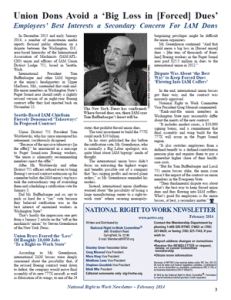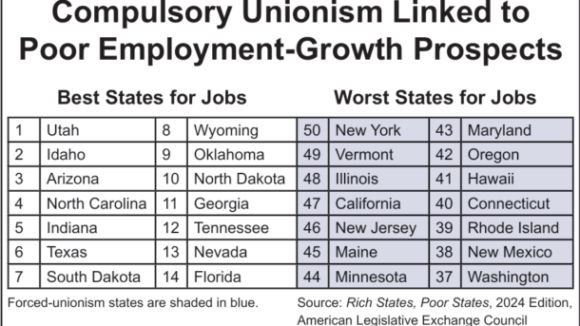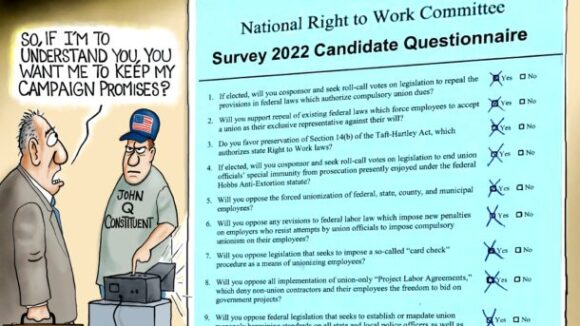Is This Any Way to Run a City’s Schools?
Leaked CTU Proposals Won’t Do Anything to Improve Schools’ Poor Performance
 Employees’ Best Interests a Secondary Concern For IAM Dons
Employees’ Best Interests a Secondary Concern For IAM Dons
(click to download newsletter)
In December 2013 and early January 2014, a number of mainstream media reports focused public attention on a dispute between the Washington, D.C. area-based hierarchy of the International Association of Machinists (IAM/AFL-CIO) union and officers of IAM Union District Lodge 751, based in Seattle, Wash.
International President Tom Buffenbarger and other IAM bigwigs at the union’s headquarters in Upper Marlboro, Md., contended that rank-and-file union members in Washington State’s Puget Sound area should ratify a slightly revised version of an eight-year Boeing contract offer they had rejected back on November 13.
Seattle-Based IAM Chieftain Fiercely Denounced ‘Takeaways’ In Proposed Contract
Union District 751 President Tom Wroblewski, who has since announced his retirement, vociferously disagreed.
“Because of the massive takeaways [in the offer],” he announced in a message to Puget Sound-area Boeing workers, “the union is adamantly recommending members reject the offer.”
After Mr. Wroblewski and other District 751 officers refused even to bring Boeing’s revised contract extension up for a member ballot, the IAM union’s top brass took the extraordinary step of overriding them and scheduling a ratification vote for January 3.
Did Mr. Buffenbarger and co. opt to push so hard for a “yes” vote because they believed ratification was in the best interest of unionized workers in Washington State?
That’s hardly the impression one gets from a January 2 article on the “rift in the machinists’ union” by Steven Greenhouse of the New York Times.
Union Brass Feared the ‘Loss’ Of Roughly 10,000 Jobs ‘To a Right-to-Work State’
According to Mr. Greenhouse, international IAM bosses were deeply concerned about the possibility that, if the revised Boeing contract went down to defeat, the company would move final assembly of its new 777X aircraft, as well as fabrication of its wings, to one of the 24 states that prohibit forced union dues.
The total investment to build the 777X could reach $10 billion.
In his story published the day before the ratification vote, Mr. Greenhouse, who is normally a Big Labor apologist, was quite blunt about IAM bigwigs’ mode of thought.
The international union brass didn’t focus on extracting the highest wages and benefits possible out of a company that “has surging profits and record plane orders,” as Mr. Greenhouse reminded his readers.
Instead, international union chieftains worried about “the possibility of losing a large manufacturing center to a right-to-work state” where securing monopoly-bargaining privileges might be difficult for union organizers.
Mr. Greenhouse continued: “And that could mean a big loss in [forced union] dues – [the tens of thousands of front-line] Boeing workers in the Puget Sound area paid $25.5 million in dues to the international union in 2012.”
Dispute Was About ‘the Best Way’ to Keep Forced Dues ‘Flowing Into IAM Coffers’
In the end, international union bosses got their way, and the contract was narrowly approved.
National Right to Work Committee Vice President Greg Mourad commented:
“Rank-and-file union members in Washington State may reasonably differ about the merits of the new contract.
“It includes modest raises, a $10,000 signing bonus, and a commitment that final assembly and wing build for the 777X will occur in the Puget Sound region.
“It also switches employees from a defined-benefit to a defined-contribution pension plan and requires them to pay a somewhat higher share of their health-care costs.
“But for Tom Buffenbarger and Local 751 union bosses alike, the main issue wasn’t the impact of the contract on union members in the Evergreen State.
“Their fundamental dispute was about what’s the best way to keep forced union dues and fees flowing into IAM coffers. What’s good for employees is for union bosses, at best, a secondary matter.”

Leaked CTU Proposals Won’t Do Anything to Improve Schools’ Poor Performance

Wherever Big Labor wields the power to collect forced union dues, union bosses funnel a large share of the confiscated money into efforts to elect and reelect business-bashing politicians. Employment growth tends to lag as a consequence.

Members Insist They Keep Pro-Right to Work Campaign Promises